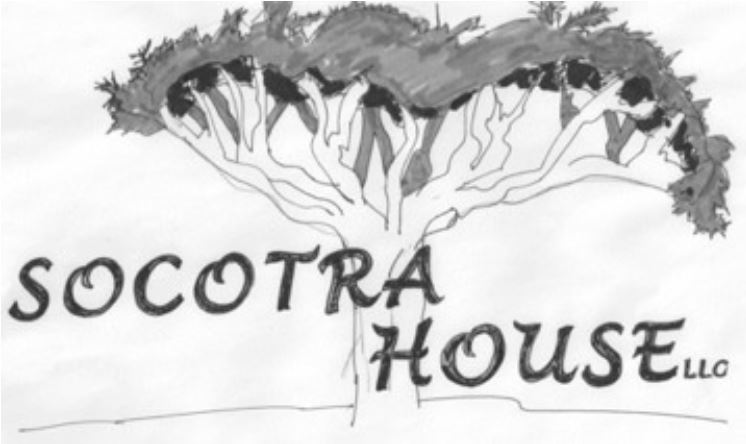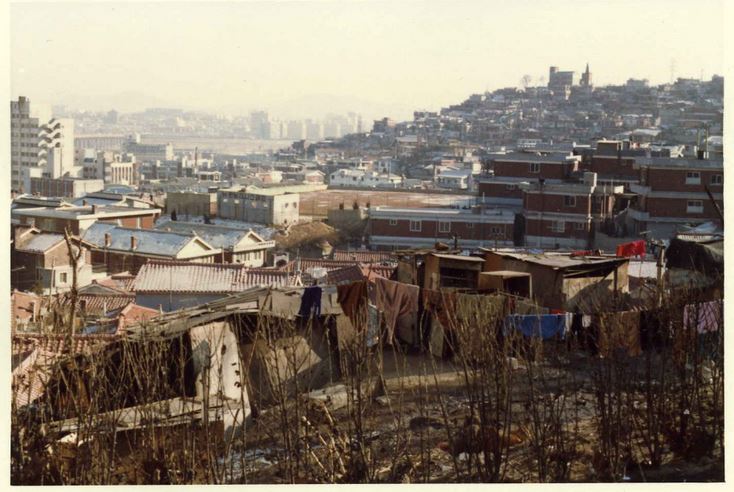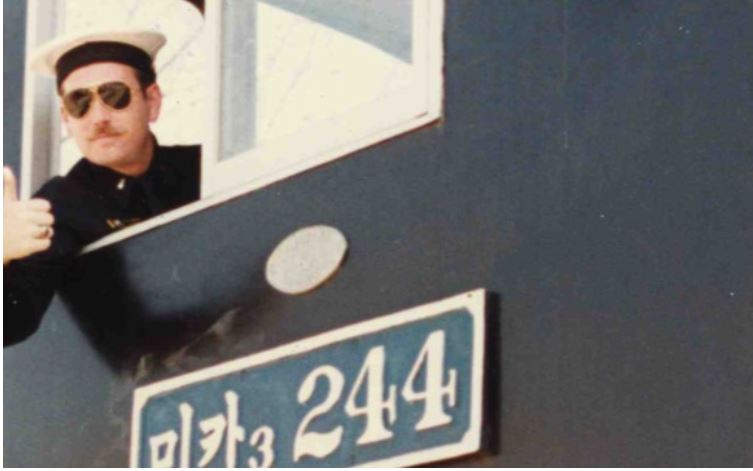New Adventures

(Original logo artwork at Socotra House founding. Art by Stacy Hoffhine, 2002)
Author’s Note: These are exciting and historic times. Socotra House has an exciting new project in the works that will dramatically expand the scope of work of the company. As a part of that, the following represents a portion of a new line of works that will outline how we have all arrived at this point in the life of our nation and our world. Stand by- there is much more to come!
– Vic
10 February 2001
Seoul Dogs

(Seoul, Republic of Korea citiscape from the slope of Namsan Mountain, circa February 1981. Image Socotra).
Important dining tip: there is Bul-gogi and there is Kay-gogi. The Bul-gogi is the sliced beef. The Kay-gogi isn’t, and it is why there are few stray dogs in the Itae-won district of Seoul. It is supposed to help you feel vigorous. We got in trouble down in the southern port city of Pusan years ago when one of my waggish buddies asked the owner of a Kay-gogi restaurant if he could get some of the paws to take home. But those were the bad old days. That was when we called the Republic of Korea the ROK, and the people that lived there the ROKs.
We are back, and it is colder than hell out there. The lobby of the Shilla Hotel is freezing, and looking out the revolving door you can see the cold gathered against the rugged mountains in the distance. We are on the shoulder of Namsan Mountain that dominates Seoul. We look out over the university and towards the downtown. It is clear and the snow is drifted and there is sheet ice on the pavement. Our Infantry tried running outside earlier, and they came back with near frostbite. There was a time when we had run up the mountain for luck, up the narrow rocky paths and up the granite steps cuts into the living rock. But that was years ago, just after the military government of Chon Tu-Hwan came to power, in the time when the students had risen in the Cholla Province town of Kwang-ju and the ROK Special Forces then cut them down by the hundreds.
Last night was the coldest in recorded history near the Demilitarized Zone, -16 below. Granted, recorded history here only goes back to official records kept since 1947, but it was still colder than hell. A little vent on my window allowed the frigid blast to curl a tendril into my room, and my gym clothes froze before they could dry.
There was a lot of baggage on this Peninsula, much of it corporate and some of it personal. I had come here the first time in 1980. President Park was freshly in his grave, victim of the Night of the Generals when the tanks rolled in the streets of Seoul and the ostensible Commander, a four-star American, was forced to fly reconnaissance missions over his own headquarters to find out what was happening. The North was aggressive, too. We had the annual infiltration season, with mystery boats and frogmen swimming ashore, and periodic firefights along the Demilitarized zone. Kim Dae Jung, once President, was in jail for his links to the Communists. It was a military backwater, rustic after serving in the bright lights of Japan for two years on USS Midway (CV-41). They offered me a one-year tour in Korea to “even up” with the three-year tours the people had stateside. Back then, I sighed and said “OK,” disappointed in another year overseas. And not realizing I would have one of those adventures in a life.
Much had changed in the last twenty years. With the Seoul Olympics came the Subway, not the sandwich place, and the end of the good deals in shopping. The hour-long drive in the country on the way down to Osan Air Base was now festooned with mile after mile of great block apartment buildings, stretching as far as the eye can see.
We had arrived from Shanghai two nights before. We were met by a rumpled Air Force Major in camouflage Battle Dress Uniform and a bulky camouflage parka. He had a van and a ROK driver…the acronym floated back into my brain from years before….he was a KATUSA….a Korean Augmentee to the United States Army. It was a great deal for the young draftees, since they lived on the U.S. post at Yongsan Garrison, not with their fellow Koreans. Draftees lived a harsh and brutal existence in the ranks, or maybe it was brutal and harsh. I forget which.
Our driver professed to know no English, and we accommodated him by talking freely. I remember a long-ago trip to inspect the fortifications on the DMZ. The skies that day were bottomless blue, not a cloud in them, and the sunlight flooded in through the gunports. A ROK Army Colonel was our host, and he professed no English. Our guide was a young ROK Private named Kim- everyone here was a Kim of one rank or another- and he was from LA. His father owned an import-export business there, he explained, and he had been drafted back home. In order to fulfill family honor, he came, leaving his surfboard in El Segundo. His colloquial English made him a huge hit with our group (“Gnarly tunnels up here!”) and I could see the upstaged Colonel seething. I expect Private Kim was treated to a beating after we left.

We also saw the famous black steam locomotive, parked on a truncated track facing North. The ROKs had made it a memorial to Unification, since it faced a railway bridge over the Imjin River that had got knocked down and now was located between the fences that ran up hill and down dale all across the rugged spine of the severed nation. This week the engineers were working to open the line, and you could sense that unification of some kind was sweeping down. That was part of my baggage.
The Truce Village of Panmunjong was not far from the locomotive, a surreal little compound where two imposing national buildings faced each other from the north and south ends of the camp. The ROK building was colorful and traditional. The North Korean version was also traditional, but vaguely Stalinesque. It was built to be imposing, but was only as thick as a single room. In the middle was the hut where the negotiations took place, and the DMZ ran right down the middle of the table. They permitted you walk around to the other side, under careful supervision. It was spooky then to walk into North Korea, with their soldiers peering in the window at you. Not knowing I had a trip coming to the capital of the North.
Loudspeakers constantly played martial tunes in the background, and insanely large national flags flew from what looked like radio masts on both sides. A bucolic Potemkin farming village lay nearby, but no one lived there. It was all for show. The soldiers on the southern side called it the Propaganda village. On a clear day, you could see the 40-meter statue of the Great Leader Kim Il Sung up the coast at Wonsan. It took no effort at all to see the stump of the tree whose trimming had prompted the murder of two U.S. soldiers near the Bridge of No Return.
Like I said, there is a lot of baggage on this Peninsula.
Some years later I was smoking cigarettes with Kim Yong Sun, whose card identified him as the Secretary of the Central Committee of the Worker’s Party of Korea, and Chairman of the Reunification Policy Committee of the Supreme People’s Assembly of the Democratic People’s Republic of Korea.
He was a sly old Communist with a droll wit who did not bother to profess not speaking English. We were on the seventh floor of an apartment building in central Pyongyang. We were there to advance the Agreed Framework on reducing the North’s nuclear fissile materials. He asked me how aircraft carriers could be construed as “defensive weapons.” I explained that it all depended on what it was, exactly, that was being defended, and from what distance you wanted to do it. He laughed and his dark eyes twinkled behind his gold-framed glasses. Twenty years ago we were talking, and the North began to recognize it could not free its people. Then, at the turn of the millenium, it appeared that some sort of unification was really a possibility.
Then, I supposed it must be inevitable. My reasoning was on the principle that since there may have been fewer stray dogs in Seoul, there was room and food for them. But were are no dogs at all north of the Imjin river. We live and learn, though. During the Kwang-Ju subjugation it would have been unthinkable. It got easier with age. Now I don’t understand it at all.
Copyright 2022 Vic Socotra
www.vicsocotra.com
